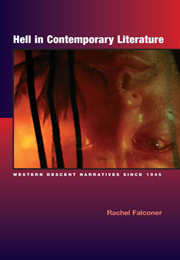Book contents
- Frontmatter
- Contents
- Acknowledgements
- Introduction: Descent and Return – the katabatic imagination
- 1 Hell in Our Time
- 2 Chronotopes of Hell
- 3 Auschwitz as Hell
- 4 Surviving with Ghosts: Second-generation Holocaust Narratives
- 5 Katabatic Memoirs of Mental Illness
- 6 Engendering Dissent in the Underworld
- 7 Postmodern Hell and the Search for Roots
- 8 East-West Descent Narratives
- Epilogue: Katabasis in the Twenty-First Century
- Appendix: Primo Levi, ‘Map of reading’
- Bibliography
- Index
2 - Chronotopes of Hell
Published online by Cambridge University Press: 12 September 2012
- Frontmatter
- Contents
- Acknowledgements
- Introduction: Descent and Return – the katabatic imagination
- 1 Hell in Our Time
- 2 Chronotopes of Hell
- 3 Auschwitz as Hell
- 4 Surviving with Ghosts: Second-generation Holocaust Narratives
- 5 Katabatic Memoirs of Mental Illness
- 6 Engendering Dissent in the Underworld
- 7 Postmodern Hell and the Search for Roots
- 8 East-West Descent Narratives
- Epilogue: Katabasis in the Twenty-First Century
- Appendix: Primo Levi, ‘Map of reading’
- Bibliography
- Index
Summary
In the last chapter, I discussed what Hell might mean to a contemporary secular Westerner. Here I would like to shift the focus to what narratives of Hell characteristically do and, in terms of their formal attributes and generic characteristics, how they work. In Bakhtin's view, literary genres are defined by their chronotopes, their distinctive representations of time and space and the human image within that timescape. Of the two elements that comprise a chronotope (time and space), the most important one for defining the particular characteristics of a genre is time. In Gary Saul Morson's paraphrase of Bakhtin, ‘each narrative genre implicitly manifests a specific model of temporality.’ To say of an experience or event that ‘it was Hell’ is to evoke a generic horizon of expectation in the listener or reader. ‘Hell’ itself is a chronotope whose most familiar inherited temporal and spatial features include: narrow constraints on spatial movement, an absence of future orientation, experienced by an individual both separate and alienated from his or her environment and from other people, despite often being crowded into close proximity with others in an undifferentiated mass. But if we are to appreciate the ways in which contemporary writers have challenged and redefined the horizons of traditional katabatic narrative, we need to examine this generic inheritance in considerably greater detail.
Generic features of katabatic narrative
Although often found as an episode embedded in other types of narrative, the story of an infernal journey may still be described as a distinct genre in itself in that it codifies a particular world-view, operates according to a certain narrative dynamic, and draws upon an inherited set of motifs and imagery.
- Type
- Chapter
- Information
- Hell in Contemporary LiteratureWestern Descent Narratives since 1945, pp. 42 - 62Publisher: Edinburgh University PressPrint publication year: 2004



